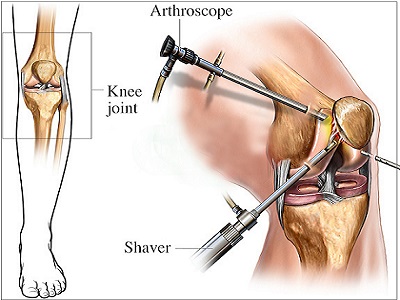



Arthroscopic Surgery

Arthroscopy
Arthroscopy is a surgical procedure orthopaedic surgeons use to visualize, diagnose, and treat problems inside a joint.
The word arthroscopy comes from two Greek words, “arthro” (joint) and “skopein” (to look). The term literally means “to look within the joint.”
By attaching the arthroscope to a miniature television camera, the surgeon is able to see the interior of the joint through this very small incision rather than a large incision needed for surgery.
The television camera attached to the arthroscope displays the image of the joint on a television screen, allowing the surgeon to look, for example, throughout the knee. This lets the surgeon see the cartilage, ligaments, and under the kneecap. The surgeon can determine the amount or type of injury and then repair or correct the problem, if it is necessary.
The parts of the shoulder joint as seen through an arthroscope: the rotator cuff (RC), the head of the humerus (HH), and the biceps tendon (B).
Why is arthroscopy necessary?
Diagnosing joint injuries and disease begins with a thorough medical history, physical examination, and usually X-rays. Additional tests such as magnetic resonance imaging (MRI) or computed tomography (CT) also scan may be needed.
Related Articles
TREATMENT
Knee Arthroscopy
TREATMENT
Shoulder Arthroscopy
TREATMENT
Wrist Arthroscopy
RECOVERY
Knee Arthroscopy Exercise Guide
Through the arthroscope, a final diagnosis is made, which may be more accurate than through “open” surgery or from X-ray studies.
Disease and injuries can damage bones, cartilage, ligaments, muscles, and tendons. Some of the most frequent conditions found during arthroscopic examinations of joints are:
Inflammation
For example, synovitis is an inflammation of the lining in the knee, shoulder, elbow, wrist, or ankle.
Acute or Chronic Injury
- Shoulder: Rotator cuff tendon tears, impingement syndrome, and recurrent dislocations
- Knee: Meniscal (cartilage) tears, chondromalacia (wearing or injury of cartilage cushion), and anterior cruciate ligament tears with instability
- Wrist: Carpal tunnel syndrome
- Loose bodies of bone and/or cartilage: for example, knee, shoulder, elbow, ankle, or wrist
Some problems associated with arthritis also can be treated. Several procedures may combine arthroscopic and standard surgery.
- Rotator cuff surgery
- Repair or resection of torn cartilage (meniscus) from knee or shoulder
- Reconstruction of anterior cruciate ligament in knee
- Removal of inflamed lining (synovium) in knee, shoulder, elbow, wrist, ankle
- Release of carpal tunnel
- Repair of torn ligaments
- Removal of loose bone or cartilage in knee, shoulder, elbow, ankle, wrist.
Although the inside of nearly all joints can be viewed with an arthroscope, six joints are most frequently examined with this instrument. These include the knee, shoulder, elbow, ankle, hip, and wrist. As advances are made in fiberoptic technology and new techniques are developed by orthopaedic surgeons, other joints may be treated more frequently in the future.
How is arthroscopy performed?
Arthroscopic surgery, although much easier in terms of recovery than “open” surgery, still requires the use of anesthetics and the special equipment in a hospital operating room or outpatient surgical suite. You will be given a general, spinal, or a local anesthetic, depending on the joint or suspected problem.
A small incision (about the size of a buttonhole) will be made to insert the arthroscope. Several other incisions may be made to see other parts of the joint or insert other instruments.
When indicated, corrective surgery is performed with specially designed instruments that are inserted into the joint through accessory incisions. Initially, arthroscopy was simply a diagnostic tool for planning standard open surgery. With development of better instrumentation and surgical techniques, many conditions can be treated arthroscopically.
For instance, most meniscal tears in the knee can be treated successfully with arthroscopic surgery.
The surgeon inserts miniature scissors to trim a torn meniscus.
After arthroscopic surgery, the small incisions will be covered with a dressing. You will be moved from the operating room to a recovery room. Many patients need little or no pain medications.
Before being discharged, you will be given instructions about care for your incisions, what activities you should avoid, and which exercises you should do to aid your recovery. During the follow-up visit, the surgeon will inspect your incisions; remove sutures, if present; and discuss your rehabilitation program.
The amount of surgery required and recovery time will depend on the complexity of your problem. Occasionally, during arthroscopy, the surgeon may discover that the injury or disease cannot be treated adequately with arthroscopy alone. The extensive “open” surgery may be performed while you are still anesthetized, or at a later date after you have discussed the findings with your surgeon.
Arthroscopy is a common surgical procedure in which a joint (arthro-) is viewed (-scopy) using a small camera. Arthroscopy gives doctors a clear view of the inside of the knee. This helps them diagnose and treat knee problems. Technical advances have led to high definition monitors and high resolution cameras. These and other improvements have made arthroscopy a very effective tool for treating knee problems. According to the American Orthopaedic Society for Sports Medicine, more than 4 million knee arthroscopies are performed worldwide each year.
Description :
Arthroscopy is done through small incisions. During the procedure, your orthopaedic surgeon inserts the arthroscope (a small camera instrument about the size of a pencil) into your knee joint. The arthroscope sends the image to a television monitor. On the monitor, your surgeon can see the structures of the knee in great detail. Your surgeon can use arthroscopy to feel, repair or remove damaged tissue. To do this, small surgical instruments are inserted through other incisions around your knee.
Arthroscopic knee surgery
Knee injuries and conditions come in all types and degrees of severity. While some conditions require surgeons to replace part or all of the knee joint, other conditions may only require that the ligaments, cartilage and tendons within and around the knee joint be treated or repaired.
About knee arthroscopy
Knee arthroscopy is a minimally invasive surgical procedure, usually performed on an outpatient basis. Your surgeon uses miniature cameras and instruments to get a better view of the inner workings of your knee. This increases surgical precision and typically minimizes the number and size of surgical incisions. The arthroscope is also often used to assist the surgeon’s visualization in other more complex surgeries; in some cases, additional incisions are needed.
Orthopedic surgeons use arthroscopy to diagnose and sometimes treat knee conditions. The procedure is most effective in treating injuries and conditions that affect, or have caused damage to, the cartilage, ligaments, tendons and other soft tissues that surround, protect and enable your knee to function properly.
*** 20% Cost – Pay EMI (Monthly) Available *** Health Insuresnce Available
About us
Hospital offers Multispeciality treatment and facilities on par with the best available globally. From a 24-hour ambulance service, pharmacy and diagnostic centre, to specialised services and more. Best hospital in kukatpally
info@padmajahospital.in
WHY CHOOSE US
24×7 ICU
21+ Years of Experience
150+ Arthroscopy Surgeon
900+ Facial cases
Affordable cost
Top rated cosmetic surgery centre
Board certified plastic surgeons
Attached diagnostics
Full Body Liposuction (One Sitting )







